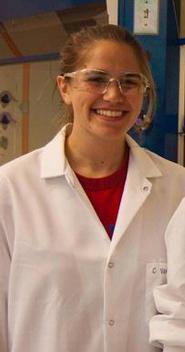
When viewing our existence from a molecular level, one miniscule change can have enormous repercussions. Carbon dioxide, for example, is the natural waste product of our respiration; but carbon monoxide (the same molecule but with one less oxygen atom) is toxic to us when inhaled. Similarly, a molecule’s orientation can also affect the way the body processes it. For her research this summer, Cara Vennari ’12 is working under Associate Professor of Chemistry Ian Rosenstein to expand ring molecules that have three carbon atoms in them to contain five.
At room temperature, cyclopropanes are extremely volatile and explosive due to their high potential energy. But cyclopentane, the five-carbon ring, has many industrial applications, ranging from the manufacture of rubber adhesives to polyurethane insulation to use in refrigerators and freezers as a replacement for damaging chlorofluorocarbons. So, understandably, the synthesization of a cyclopentane, as well as its influential orientation, is extremely important due to its commercial application.
But Vennari is most concerned with the stereochemistry, or the orientation of the molecule. “Each carbon has four bonds on it, and there are two ways in which the molecules off the carbon can be oriented,” Vennari said. “When your body recognizes molecules, it recognizes not only what’s in it but how it’s put together. Just one change can be really important.”
After starting with a commercially-available cyclopropane molecule, Vennari replaces the components to make the molecule she wants. She then uses chiral auxiliaries, temporary molecules that act as a gateway for the attacking molecule to find a specific location, to add the additional molecules to the ring. The added molecules bond to free radicals, or active unpaired electrons, on the preexisting ring, attaching them to the desired location.
“The distribution [of the carbon] has to do with how the atoms around the stereocenter are oriented. Hopefully we would be able to see how the different chiral auxillaries off of the cyclopropane affect the stereocenters,” Vennari said.
Vennari’s summer research was funded through the Edward and Virginia Taylor Fund for Student/Faculty Research in Chemistry, established in 2008 through a gift from Ted ’46 and Virginia to inspire students interested in chemical research and to facilitate their work with outstanding faculty.
A chemistry major and mathematics minor, Vennari is also a member of the varsity softball team. She enjoys hiking, playing tennis, and rooting for her favorite San Francisco teams: the Giants and the 49ers.
Vennari graduated from the Bay School (Calif.).
At room temperature, cyclopropanes are extremely volatile and explosive due to their high potential energy. But cyclopentane, the five-carbon ring, has many industrial applications, ranging from the manufacture of rubber adhesives to polyurethane insulation to use in refrigerators and freezers as a replacement for damaging chlorofluorocarbons. So, understandably, the synthesization of a cyclopentane, as well as its influential orientation, is extremely important due to its commercial application.
But Vennari is most concerned with the stereochemistry, or the orientation of the molecule. “Each carbon has four bonds on it, and there are two ways in which the molecules off the carbon can be oriented,” Vennari said. “When your body recognizes molecules, it recognizes not only what’s in it but how it’s put together. Just one change can be really important.”
After starting with a commercially-available cyclopropane molecule, Vennari replaces the components to make the molecule she wants. She then uses chiral auxiliaries, temporary molecules that act as a gateway for the attacking molecule to find a specific location, to add the additional molecules to the ring. The added molecules bond to free radicals, or active unpaired electrons, on the preexisting ring, attaching them to the desired location.
“The distribution [of the carbon] has to do with how the atoms around the stereocenter are oriented. Hopefully we would be able to see how the different chiral auxillaries off of the cyclopropane affect the stereocenters,” Vennari said.
Vennari’s summer research was funded through the Edward and Virginia Taylor Fund for Student/Faculty Research in Chemistry, established in 2008 through a gift from Ted ’46 and Virginia to inspire students interested in chemical research and to facilitate their work with outstanding faculty.
A chemistry major and mathematics minor, Vennari is also a member of the varsity softball team. She enjoys hiking, playing tennis, and rooting for her favorite San Francisco teams: the Giants and the 49ers.
Vennari graduated from the Bay School (Calif.).
Posted July 24, 2010
